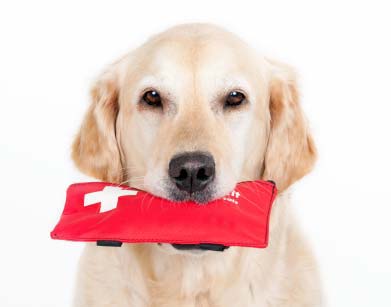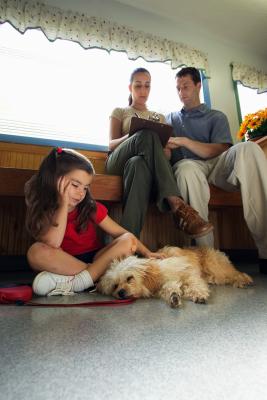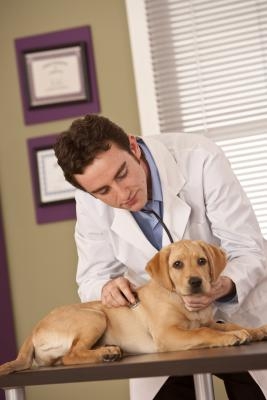Do you know what to do if you encounter a dog in an emergency situation? Whether it's your own dog or a dog you've never seen before, your actions can save a life. Here are some steps you can take.
Two Crucial Steps
In every dog health emergency stay calm and think. Approach an injured dog cautiously. Dogs may become aggressive when they are fearful or in pain. If the dog bites you or you become injured yourself you won't be able to help.
Dog Emergency 1 -- Traffic Accident
Do not try to move an injured dog. He may bite or he may be seriously injured. Call the nearest animal shelter or animal control for help. If they cannot or will not come to help you and you have to move the dog on your own, find a blanket and slide it under the dog. Try to avoid the dog's head. With another person (if possible) life the dog to your vehicle. If the dog is cooperative, check for heartbeat and bleeding. Try to stop any excessive loss of blood by holding a clean cloth or pad over the wound. Secure it tightly and try to make a makeshift bandage. Take the dog to the closest vet. Call ahead if possible to prepare them for an emergency. In some cases, such as late nights, you may have to find an animal emergency room.
Dog Emergency 2 -- Burns
1. Hold the burned body part in cold running water as long as possible. 2. If the burn is from a caustic substance wash it off. 3. Call your veterinarian.
Dog Emergency 3 -- Heat stroke
With heat stroke the dog is overheated and without sufficient air. This can occur in an enclosed space, such as a car, or it can occur on a hot day in the open air. The dog may be panting, vomiting, showing pale gums, frothing at the mouth, or already collapsed. 1. Remove the froth. 2. Place cold compresses on the dog's pads, stomach and groin to begin lowering body temperature. 3. Take the dog immediately to the veterinarian for treatment. Treatment usually consists of more cold water, drugs and observation. Do NOT try to get the dog to ingest large quantities of cold water too quickly. Doing so can induce bloat.
Dog Emergency 4 -- Dog Poisoning
With poisoning look for muscular twitching, vomiting, bleeding, convulsion or collapse. 1. Have someone call the vet immediately. 2. Follow the vet's advice. Different poisoning cases sometimes have to be treated differently. 3. If you cannot reach the vet try to induce vomiting. Salt and mustard in water usually will do the trick. Ipecac is also good to have on hand for these emergencies. Or you can get your dog to drink hydrogen peroxide (3% solution for wounds). 4. If you know what the poison is, take some of it with you to the vet's office.
Emergency 5 -- Dog Choking
If your dog is choking open his mouth carefully and try to see what is causing the problem. It could be anything: a small ball, bone, stick, meat wrapping. Sometimes you can dislodge the item by using your fingers. Pump the chest by pressing down on the ribs and releasing immediately at five-second intervals. If this doesn't dislodge the object within a few moments, rush the dog to the nearest animal hospital to have the foreign object removed under anesthetic. Do not wait.
Dog Emergency 6 - Drowning
Remove the dog from the water. Try to get the water out of the dog's lungs as soon as possible by pumping the chest as for choking (see above). Take the dog to the vet to be checked out.
All of these emergencies are frightening when they happen but by remembering a few basic things you can help your dog and get through them. Many animal shelters and other pet-related businesses offer pet emergency courses. If you're interested in learning more you can check into them and sign up when you have the chance.

 7 Tips to Training Your Puppy
7 Tips to Training Your Puppy
7 Tips to Training Your Puppy
7 Tips to Training Your Puppy
 Dangerous Foods for Dogs
It’s only natural for dogs to
Dangerous Foods for Dogs
It’s only natural for dogs to
 How to Tell if a Dog is Dehydrated
How to Tell if a Dog is Dehydrated
How
How to Tell if a Dog is Dehydrated
How to Tell if a Dog is Dehydrated
How
 Understanding Teething in Puppies
Understanding Teething in Puppies
Understanding Teething in Puppies
Understanding Teething in Puppies
 What Kinds of Dogs Have Fewer Health Problems?
What Kinds of Dogs Have Fewer Health Problems?
What Kinds of Dogs Have Fewer Health Problems?
What Kinds of Dogs Have Fewer Health Problems?